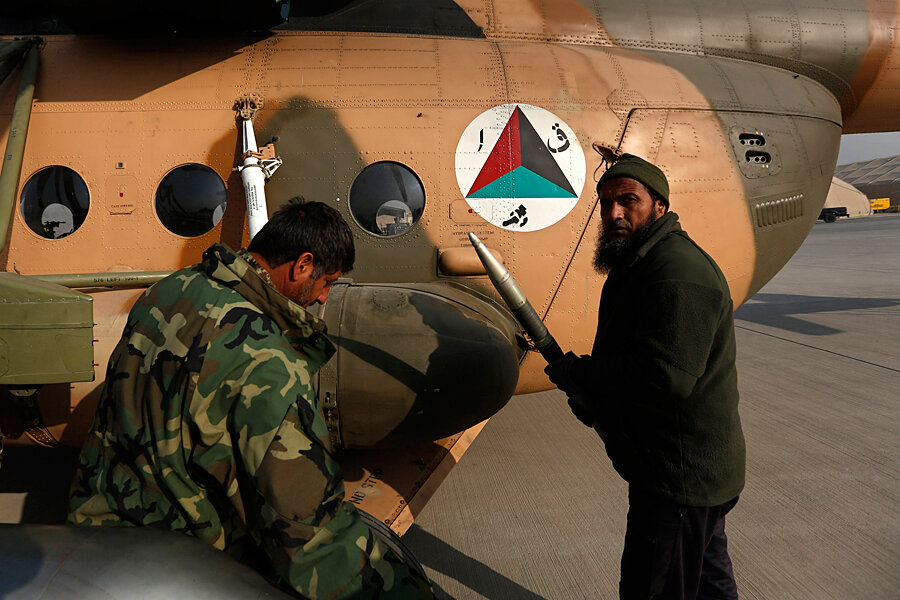Afghan Taliban show resilience despite years of US 'capture-kill' policy
Loading...
| Kabul
Months after the US military ended major combat operations in Afghanistan, the Taliban appear poised to significantly challenge the newly formed Afghan government despite taking some heavy losses.
The persistence of the Taliban in many parts of Afghanistan follows a year in which US and Afghan forces killed or captured nearly three dozen leaders of the militant group’s shadow government administration.
The Taliban nonetheless made considerable gains, inflicting a record number of casualties against Afghan security forces, capturing new ground in the countryside, conducting major attacks inside the capital, and receiving a boost from a record opium harvest. They did so despite the fact that some 10,000 to 12,000 of their fighters were killed, captured, or wounded in 2013, painting a picture of an organization now adept at dealing with the loss of its leaders, as well as of rank-and-file soldiers.
Throughout the Afghan war, the US conducted capture-kill operations, missions designed to target key militant leaders. Such operations were most commonly used under US Army Gen. David Petraeus from 2010-2011. A report by the independent Afghanistan Analysts Network that analyzed press releases by the International Security Assistance Forces from Dec. 1, 2009 to Sept. 30, 2011 found that ISAF reported operations that killed 3,873 individuals and detained 7,146. Among those, 174 described as leaders were killed and 501 were detained.
More recently, the Long War Journal determined that international and Afghan forces last year killed or captured 34 Taliban administrators, including seven shadow governors.
Yet Taliban insurgents appeared largely unaffected. Some say their gains speak more to the drawdown of international troops than to growing Taliban strength. But others worry that even when there is a window to rein in Taliban influence, especially through local efforts, there is not enough support from Afghan security forces to sustain the effort.
“Capture and kill operations have been carried out not only in 2014, but over the last 13 years and they have not had any major impact on our activities,” Ihsaanullah Ishani, a mid-level Taliban commander in southern Helmand Province, said during a phone interview.“One of the rules for us is that if there is a gap, you should fill it very quickly.”
Mr. Ishani says the Taliban take great care to replace fallen commanders with experienced replacements, and draw from deputies and close colleagues to those who were killed or taken.
A toll for both sides
Yet despite the apparent resilience, the loss of so many leaders has left a mark on the Taliban. Throughout the countryside, many commanders or administrators with years of experience were often replaced with young fighters new to the battlefield. Many of these young men, frequently only in their 20s, developed reputations for brutality and abuses of authority that alienated locals.
“The new generation is creating a gap between society and the Taliban,” says Sami Yousafzai, a Pakistani journalist and terrorism expert.
The targeting of leaders may also have an unintended consequence for the government, analysts say, as it complicates reconciliation efforts by eliminating known or experienced figures who aid in potential peace talks. Already, international and Afghan officials struggled to find suitable people to bring to the table. In one case in late 2010, a Taliban impostor duped NATO and Afghan officials, pretending to be a senior official ready to begin peace talks. The incident caused embarrassment and was one of many setbacks to the reconciliation effort.
“There is not much of an effect except for killing those who are known leaders in the Taliban movement and eliminating possible contacts in the search for a political solution,” says Thomas Ruttig, co-director of the Afghanistan Analysts Network.
Afghan security officials, when asked to comment on capture-kill, defer to American counterparts, saying they have little to do with operations that target specific individuals. Although the US military has ended its major combat operations, it will continue to operate in an extremely limited manner, mainly targeting members of Al Qaeda and working to further develop Afghan security forces.
“As President Obama has made clear, US forces under Operation Freedom’s Sentinel will continue to target the remnants of Al Qaeda to ensure that Afghanistan is never again used to stage attacks against our homeland,” says US Army Lt. Col. Chris Belcher, spokesman for the Resolute Support Mission in Afghanistan. “The primary focus of our mission, Resolute Support, is to continue building the capability and capacity of our Afghan security partners through training and assistance activities.”
Finding a window to broker local peace deals
In parts of Afghanistan, some local leaders have managed to take advantage in gaps in Taliban leadership to broker peace deals with Taliban militants in their area. In Kandahar’s Panjway district, Haji Faisal Mohammed, the district governor reached out to fighters after their shadow governor was killed in operations a year and a half ago. The effort resulted in the official reconciliation of about 200 fighters, and many more unofficially returned to their homes, he says.
“Now Panjway is peaceful and people here understand what life is again. They’re living a real life with peace,” he says. “The increased attacks last year don’t mean that the Taliban got stronger. It was because the foreigners decided to leave. It was a morale boost for the Taliban. They didn’t achieve that much from their attacks – they just wanted to show that they’re stronger.”
Among Afghan civilians there are questions about whether such localized efforts will be enough.
Haji Muzamel, a tribal leader in Dangam District of Kunar Province, which has seen some of the hardest fighting in Afghanistan, says that capture-kill operations have been fruitful in parts of the province, but that Afghan security forces lack the ability to make sustained progress.
Mr. Muzamel’s village was recently attacked by Taliban militants. The locals resisted and called the government for help. But Afghan forces failed to respond in time. As a result, Muzamel says he and the other villagers had to withdraw from their town and the Taliban forces burned down many of their homes.
“If the foreigners are not here, the ANSF cannot eliminate this virus. There is a strong need for the foreign forces to continue their military operations against the Taliban and Al Qaeda, and capture or kill the key leaders for the Taliban,” he says.








